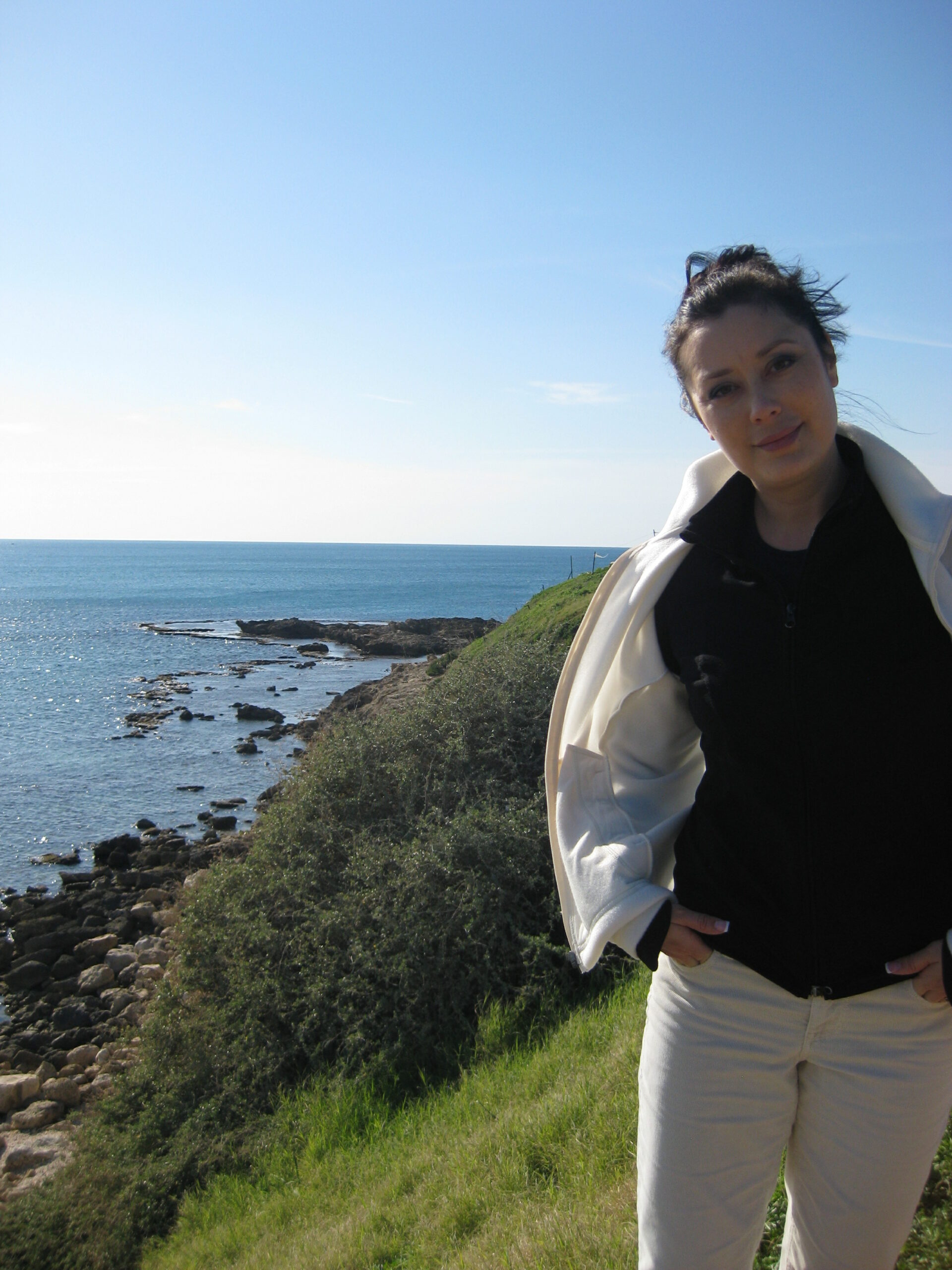
15 Feb My 2010 Israel Travel Blog
February 1 and 2: Shofar
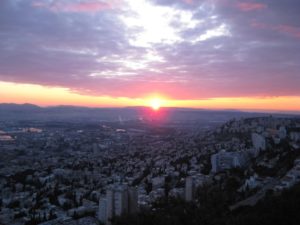 There is something wrong about the waking-up side of 4am—this, the sacred realm of paper routes, donut makers and deviantly-wired morning types.
There is something wrong about the waking-up side of 4am—this, the sacred realm of paper routes, donut makers and deviantly-wired morning types.
I barely remember the drive to Omaha, the flight to Newark. This layover will go on for nigh on ten hours—all of it spent working, lunching, working out at a nearby Wyndham, which has a fine tuna salad sandwich.
I admit to a dislike of Newark and its airport. I have been stranded here one too many times (if not as many as O’Hare). But neither is any scheduling shenanigan that might lead to missing the evening flight to Tel Aviv.
By 9:30pm, the 10:50 flight is lining up for screening into the secured Tel Aviv gate. I have already been fascinated once today in watching a Hassidic Jew half undress at security. You have no idea how much I wanted to touch his tzitzits.
I know. There’s a special place in Sheol reserved for me for that.
On the plane, the girl next to me looks lost. “This is my first international flight,” she says. The attendants have no mercy. “Turn off your phone. Put your bag up. Clear the aisle way.” I show her after we’re airborne how to take out her TV, pull out the console complete with mini keyboard and gaming joystick. “See?” I show her how to plug her earbuds into the adapter on the airline set.
“This is all so complicated!” she says.
Well, I guess it kind of is.
She doesn’t like the kosher meal her family ordered for her. Asks for a regular one, too. And then eats sushi in between. I watch all of this, fascinated. It all seems rather complicated.
An hour and a half before landing, she says, “Wow. You were out forever!”
That’s because for most of our flight it was daylight outside.
***
My group—the Biblical Archaeology Society—coalesces outside. The guide’s name is Amnon. “Do I look better in my picture or in person?” he grins.
It’s only 4pm and so we’re headed already to Jaffa. I’m glad but fighting the notion to drool against the bus window.
In Jaffa, though, everything changes. I see the Mediterranean. Here is the city where the cedar for Solomon’s temple was brought in to port to Lebanon. It is the same port given by Marc Antony to his lover, Cleopatra (when she died, Augustus gave it to Herod). The crumbling wall is lit by modern lights. Tufts of flowering greens grow out of it. A whale fountain (the whale looks much too happy) commemorates Jonoh’s attempted escape from Ninevah as he took a ship from here.
We pass two bridal parties taking photos—and join one of them for a group picture—before heading inside the old city. This area of old Arab houses later became a red light district—or, as Amonn says, “filled with men and women of the night.” It’s since been beautifully redone to house galleries, chic restaurants, and a bevy of feral cats.
Up through the corridor-like streets to the garden on the hill, we’ve reached the highest point on the city. Here in Gan ha-Pisga is a carved henge of angels ascending and descending on one side in Jacob’s dream (the angels, who have no regard for gravity descend head first), Abraham, Isaac and the ram on the other. The lintel across the top is made up of barefooted bearded fellows. “Do you see what is in their hands?” Amnon says. And how they are barefoot from the wilderness?”
“Huh. Shofars,” I say. “Must be the guys blowing down Jericho.”
It was. And I am a dork.
Below the hill, St. Peter’s Monastary is lit up against the night and looks out to sea. Here—or at some house near here—Peter was said to have visited the house of Simon the (stinky) Tanner and had his vision of the unclean animals he was to eat, a prophecy to take the word to the Gentile nations.
“Everyone thinks Christianity began in Bethlehem and Nazareth,” Amnon says. “But really, it began here.” Put that way, I suddenly remember Susan, my Jewish mom, saying Nazareth boasted little but one Christmas tree when she was here once over the holidays.
I’m having a surreal post-flight moment after a more-or-less 28-hour day that started on the drive to Omaha. Now I’m in a city said to be founded by one of Noah’s sons, idly watching five hip young Muslims—the girls with stylized hair coverings and chic t-shirts, skinny jeans and sneakers—saunter by.
We take Ben Yehuda (“son of Judah,” which might also be translated “son of Judas”) street to our hotel in Tel Aviv, a modern city a scant century old founded by some 60 families as a suburb of Jaffa.
“But this is our dream,” Amnon says, comparing it to that of Jacob with his angels. “That we would see our sons and daughters returned to this place, and here it is now—“ he indicates the tall buildings topped by blinking red lights to signal the incoming air traffic that flies directly over it—“and now see it has come true.”
I am not sure how much hummus, roasted eggplant and olives I ingested at dinner, but it was a lot.
I doze off to some British lawn sport (aren’t all British sports mostly lawn-oriented?) on TV, dreaming of modern-day Jews, ancient corridors and feral cats.
February 3: Stone
I wake at 4am without compunction, threats or blaring alarm. Hey look! I’m a morning person. Haha.
Don’t worry, Jesus isn’t coming yet.
Up early, I head out for a brisk walk along the Mediterranean. There is an international 6am fitness traffic out for their morning exercise. Breakfast an hour later is mostly smoked salmon, tuna, cheese.
Internet here costs 70 shekels a day. It makes me want to measure my PC screen in cubits.
It is overcast in Tel Aviv. We are going to Ashkelon where two days ago barrels of explosives washed up on shore from Gaza, closing down a strip of local beach.
Amnon is off and talking, rolling his Rs extravagantly. I have flashbacks of Longshanks from Braveheart. I’m curious about the other travelers in this group of 14. We have some true scholars and otherwise smart people on this trip and I feel better about my Tourette’s-style shofar-blurting yesterday.
Ashkelon is a 10,000 year-old city of commerce on the Way of the Sea, linking Syria and Egypt. Its name derives from the shekel, meaning “to weigh”—appropriate for a city of commerce. The Biblical significance is that it was one of five Philistine cities mentioned in the eulogy of David for Saul and Jonathan in 2 Samuel 1:20. It’s also linked to Samson in Judges 14. Jews lived here for several decades before the Great Revolt, during which 2500 were murdered here according to Josephus.
Trivia: a special onion comes from here with a name derived from Ashkelon—the scallion.
The city gate is very small, only a few people wide. In the event of siege, I imagine freshly-fallen enemy bodies would easily add to the local barricade. Inside are an array of African granite and Corinthian marble columns.
From Ashkelon on the coast we head inland, east toward Hebron, to Tel Maresha. The countryside is truly beautiful. Green wheat fields grow in swaths between natural vegetation and man-planted forests. The almond trees are in bloom and I think in moments I have glimpsed Eden. The wheat, however, is modern, bred to form shorter stalks. “Why spend water on hay?” Amon says. Everything is about water.
Tel MAresha (Tel = a mound built up over ages of settlement) is full of man-made bell-shaped caves. One cannot walk safely off the path here without the hazard off twisting an ankle at least or falling into a hole at worst. This is old Idumea (formerly the Edomites). This area is mentioned in 2 Chronicles 11 and 14. A hill away is the birthplace of the prophet Micah.
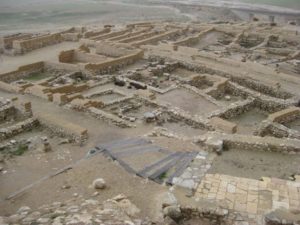 There are 169 man-made caves discovered here so far. The houses above them were created by essentially quarrying stone out of what would become the basement. The resulting spaces became home factories—olive presses, pigeon coops, baths, storage. They’re truly cavernous and you can see still the chisel marks on the ceiling, the coves chipped out for oil lamps—some high up from a time before the cave reached its full depth—where chunks of block were taken from the wall for repairs above-ground.
There are 169 man-made caves discovered here so far. The houses above them were created by essentially quarrying stone out of what would become the basement. The resulting spaces became home factories—olive presses, pigeon coops, baths, storage. They’re truly cavernous and you can see still the chisel marks on the ceiling, the coves chipped out for oil lamps—some high up from a time before the cave reached its full depth—where chunks of block were taken from the wall for repairs above-ground.
What happened here is John Hyrcanus I conquered the territory of Idumea and required the population to convert to Judaism (these are the great grandparents of Herod the Great)—before issuing a move-out-or-die edict. Residents seem to have torn down their homes and filled in the caves with the refuse in what seems to be a hell-if-you’re-living-in-the-product-of-my-hard-work reply. There are no strata here, just twenty-some feet of household stones and refuse and other items thrown together. Here they’ve found the significant stele of Helidorous.
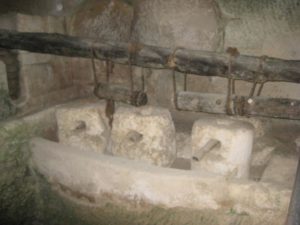 We’ve joined the dig of Ian Sterns, who has funded more than two decades of work here with his Dig for a Day program. With trowels and picks, we dig into a silo area of cave 169. Rick has found the pointy bottom and upper lip of an olive oil amphorae complete with residue. I find a shard of cooking pot, pieces of kiln. We find a few bones. On the way out of the cave, I pluck up a piece of a pot handle sticking up from the dirt floor. There’s just that much here.
We’ve joined the dig of Ian Sterns, who has funded more than two decades of work here with his Dig for a Day program. With trowels and picks, we dig into a silo area of cave 169. Rick has found the pointy bottom and upper lip of an olive oil amphorae complete with residue. I find a shard of cooking pot, pieces of kiln. We find a few bones. On the way out of the cave, I pluck up a piece of a pot handle sticking up from the dirt floor. There’s just that much here.
I ask about Menorah coins, minted by John Hyrcanus, learn the modern-day 10 coin is a replica of the ancient one.
By the time we get to Beersheba, it is frickin’ cold, windy and rainy at this settlement above the Negev plain. We descend into a huge town cistern and, afterward consider the well outside the city wall. It goes all the way to the level of the plain, below, to tap the underground river. Here it is thought that Abraham struck his covenant of Seven with Abimelech. Beersheva used to have a local alter, torn down, the stones of which were used to fortify houses, after the reforms of King Hezekiah in 2 Kings 18.
Beersheba was destroyed by earthquake—possibly the same from Amos 1. The temple at Beersheba was condemned by Amos in Amos 8. Mike, a former pastor and first century archaeologist in our group, points out that all the homes in the settlement face east—a characteristic of early Israeli homes.
Leaving Beersheba, Bedouin litter smatters the dry riverbed near the highway. They are this nation’s gypsies. Truly there is garbage all over the area. “They live the same as in Biblical times,” Amnon says, “throwing away their garbage as others used to throw it over the city wall.” Except that the garbage is now made of plastic and other bright and less biodegradable materials.
We stop at a local mall (where backpacks are searched by security at the entrance) for camera supplies by one of our members and hot tea by others. Food court vendors call to us over, street-hawker style. “Yes! Please, please, here.” He’s got the plate ready to sell us something—hummus, roasted veggies, olives and peppers, heaped on plates on the countertop. There’s a Burger King further down.
Back at the hotel, I’m ready for hot chicken broth, hummus, veggies. There is a large population of Spaniards here in the hotel restaurant. Last night I watched a chic chemical blonde make her way through a gigantenormous pile of food including a plate of bread and two whole fish. I call her the Five Laoves and Two Fishes girl.
I buy my 70 shekel internet connection so I can reconnect with you, post my first day’s blog, and get sucked into e-mail until 1am. Oops.
February 4: Green
Well, the whole morning person thing wore off pretty fast.
I eat breakfast of tuna and smoked salmon, dill and garlic yogurt, hummus. I am single-handedly responsible for the demise of countless numbers of chickpeas.
We’re headed for the Neot Kedumim Biblical Landscape Preserve near Modi’in (where the Maccabean revolt began). Despite being located amongst the hills, this is called the lowlands because it is lower than Jerusalem. It is stony here, everywhere, and nestled amongst the olive, almond and sycamore trees are ruins dating back to the Maccabees and then to Byzantium.
Here are some things I learn:
- The almond tree, the first to flower, symbolizes alertness, watchfulness, diligence.
- A woman offering to draw water—and for your camels, too!—is setting herself out for a lot of work. Many, many buckets of water. So when Abraham’s man encounters a potential wife for Isaac, she is obviously generous, strong, and hard-working. Of course, she might have seen that his ten camels were loaded with a bunch of rich goods…
- When God says the he is the living water, he is making a deliberate contrast to stagnant water, possibly in a broken cistern—one without proper plaster.
- Egypt was one of the main customers of olive oil exported from these areas.
- Tamarisk (mentioned in the Bible) acts as a natural air conditioner. Its leaves secrete salt and draw water.
- The wood of the white broom tree burns for a long while. Psalm 120:3-4 refers to the words of a false tongue being like embers of the white broom—namely the hurt never quite goes away.
- The sycamore tree is a symbol of rehabilitation because you can cut it to the ground and it will grow back. Note the implication for Zaccheus the tax collector.
We find the ruins of a chapel built for Crusaders, the altar of which is built directly over the giant basin used for crushing grapes. “Hedod!” is the sound that would have rung from these hills in that season, tannins in the air.
Here is hyssop, which is oregano. It smells delicious. I wish I had been here before writing Havah, though somehow managed to incorporate much of the same information into the story. “Purge me with hyssop,” David wrote in Psalms. Hyssop, the meek and humble plant. It is the opposite of the Lebanon cedar, the building stuff of Solomon, who was said to be wise from the hyssop to the cedar (from humble to great things). According to the preserve guide, leprosy was once considered a disease of the arrogant to make them meek. When a leper went to the Temple to be declared cured or clean of leprosy, the priest’s rite consisted of elements of both plants—a sign that the proud had been made humble.
All of this we learn to the sound of crackling gunfire on the range of the Israeli training site in the valley below us.
At the site of the Philistine settlement associated with Gath once lived nearly 30,000 people. There were Judean elements found here amidst the Philistine ones—namely statues of Astarte, the Canaanite goddess. No one really wants to talk about this much; they weren’t supposed to have these.
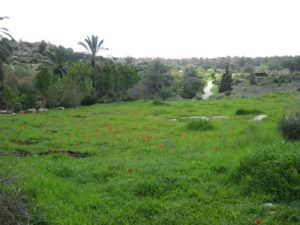 It is extremely windy as we walk along an excavated lower settlement near the city wall. You have to imagine the rest of the line of the wall today—most of the larger stones are buried under a verdant carpet of green. It is the opposite here: green and lush in winter, brown and grey and bare in summer. Despite the mud, we decide to make the trek up the tel to see the rampart. There is an Arab shepherd silhouetted against the sky, sheep and goats moving along the face of the tel. “See?” Amnon says, “the goats move independently. The sheep move in a line with their noses in the next sheep’s tukis.”
It is extremely windy as we walk along an excavated lower settlement near the city wall. You have to imagine the rest of the line of the wall today—most of the larger stones are buried under a verdant carpet of green. It is the opposite here: green and lush in winter, brown and grey and bare in summer. Despite the mud, we decide to make the trek up the tel to see the rampart. There is an Arab shepherd silhouetted against the sky, sheep and goats moving along the face of the tel. “See?” Amnon says, “the goats move independently. The sheep move in a line with their noses in the next sheep’s tukis.”
[As I am typing this, I spellcheck “tukis,” which Wikipedia calls the “Jewish word for butt.”]
It is really muddy as we veer off the edge of the tel toward a hill. This side is Philistine. This other, where we come across a group of grazing cows including an abandoned calf curled up under a tree with an infected eye, begins the hills of Judah.
We go up the Judean hill between rocks and thistles and prickly pear cacti, anemones and little purple flowers, to see the excavations of the ramparts. Up top it begins to rain, passes through, and rains again, pelting us this time with bits of ice.
I am freezing my tukis off here in the Holy Land.
On the way back, water has collected in puddles. We are muddy and sopping wet. I’m openly fantasizing about hot and sour soup, prickly pear margaritas. (I know that meal violates one international law or another, but still.)
“Wow,” the archaeologist from this site says, “This is a new experience for me.”
Back in the bus we drive away, pass a young Jewish hitch-hiker in jeans and a hoodie, the long strands of his tzitzits billowing in the breeze. I giggle. Cuz you know what I’m thinking.
We go from there to Tel Azekah to overlook the plain where David would have been most likely to meet Goliath, there in the Elah Valley. The valley below is a natural meeting place from those coming from Gath and Saul’s army. Amnon reads the Biblical account. It starts to rain.
By the time we get to Zora winery, I am only half alive. Squishing along in mud-heavy shoes and soggy socks, I’m so tired my contacts are clouded over. I struggle to stay awake during the tasting itself. I want to go directly to bed, but end up checking e-mail, eating a little dinner, joining Rick and Elliott from our tour at the bar for some wine from Golan heights. It’s really nice. While talking to Elliott, I learn of the Shabbat (Sabbath) elevator. On Shabbat, it will automatically stop at each floor so that you need not push the buttons. And so now you know.
February 5: Cardo
I’m pooped by 4pm. Pep up around 10pm at night just enough to want to try to work far later than I ought.
I ought to say something about the people in our group—publishers, retired pastors, academics, former nuclear scientists, teachers, former space and air lawyers and startup entrepreneurs. They have chosen this tour not because of emotional or religious ties to the area, but because of a historical and archaeological interest in the history and culture of this Biblical time period. Some of them follow the careers and finds of the major archaeologists whose digs we are visiting the way I follow the lives of celebrities.
We pass a lot of Kibutzes—communal living areas on land owned by (the government). 3% of the population lives here, farming. They make up 19% of the economy
Breakfast is the same—it really looks a lot like dinner including salad, pasta, sautéed green beans.
We’ve come to Antipatris, once taken by Joshua from the Caananites, once the property of the Philistines (in the first battle as Philistines gathered here against Israel, they captured the Ark of the Covenant—this, in 1 Samuel 4). In the second, they slaughtered Saul and Jonathan (read 1 Samuel 29-31). Herod the Great built here and named it after his father (Antipater). The southern battles of the Great Revolt were fought here, and the crusaders built a fortress here. You can still see part of the Herodian-era road here still—the Cardo, or Roman road. As you walk along it, partially through mud, I am amazed as I have been, at the potshards in the mud as common as pebbles. They date back to Roman times or before (or after). Some of them have ridges in them. On occasion you can see part of a pot’s curved handle poking up from the dirt. There is so much of this stuff everywhere as to be unremarkable except to outsiders and tourists from countries with young histories… like me.
We grab lunch at a mall’s food court—pizza. Some of us take filo dough with potato, cheese or spinach in it. It is served with a hard-boiled egg and pickles.
We stop by a necropolis. From there we go to Mt. Carmel, regarded as high and holy since Phoenician times. Egyptians call it the “Holy Headland.” A 4th Century author calls it the Holy Mountain of Zeus.
We visit a small chapel the name or significance of which I cannot remember; I dozed on the chapel’s simple hewn-log benches, for the duration of Amnon’s explanation. The roof is painted with a wheel of arrows pointing in the direction of an array of locations including Lebanon, Nazareth, Jerusalem.
Shabbat comes in and the dining room here is full, not just with tourists but with locals come in to eat (they are not to do the work of preparing food). Tonight the workout room closed early. I head upstairs, crash out to an old episode of the Obsornes on MTV.
February 6: Source
One thing I forgot to mention yesterday while in the necropolis. Amnon paused at the front of one sarcophagus in particular. “Do you see this? It reads: Shalom. This is my ancestor saying to me, ‘hello.’ One generation greeting another.”
Today: Megiddo or, if you believe in the last days, Har-Megeddon. This settlement’s name is carved on the walls of Karnak detailing Thutmose III’s victory here 1468BC. It probably fell to David. Solomon improved upon it. It fell later to the Assyrians. You really can see a long way in all directions over the Jezreel valley. At the head through the pass of Carmel range, Megiddo controlled the Way of the Sea.
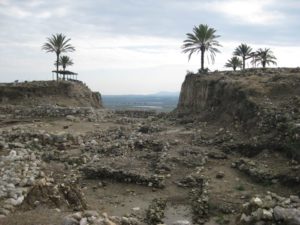 There is a great, round altar, facing mostly east when you go up the steps. The oldest temple here was built 3000 BC. The round altar came into being 500 years later. The rites that took place here were ancient, pre-Israelite. This is my nice and euphemistic way of saying that yes, we’re talking about orgies.
There is a great, round altar, facing mostly east when you go up the steps. The oldest temple here was built 3000 BC. The round altar came into being 500 years later. The rites that took place here were ancient, pre-Israelite. This is my nice and euphemistic way of saying that yes, we’re talking about orgies.
Mitchner wrote about this area. New to my reading list: The Source.
After Megiddo we go to Akko, visited by Alexander the Great, given independence by Pompey in 63 (the same year Rome entered Israel). Akko is fascinating for anyone interested in the Cruades, the Hospitaliers, or any of the history surrounding modern-era events depicted in the movie “Exodus.”
Of equal interest to me are some of the vendors inside the ancient walled city (today a modern city complete with really nice ruins that aren’t really that ruined at all). We buy pomegranate juice, freshly squeezed in front of us, from one guy—and again, a little later on, from another. We buy coconut-pistachio bars from another. The guy selling it cuts off a slice for Ron, who shares with Rick, who seems to offer me the remaining bite—but is suddenly very, very stingy at the last minute. Yes, it’s that good. We eat shawarma and falafel from a little shop, starting with “salad” from a little stand against the corner: pickles, chopped cucumber and tomato salad, hummus, dill yogurt.
We go from there to Nazareth. Nazareth in the time of Jesus might have consisted of 20-30 families—no more than a hamlet. Nazareth today is busy and sprawling upon the hills. Repair shops, stores, restaurants, churches, mosques. The Muslim presence is strong and noticeable in this city (which was no more than a hamlet in the time of Jesus) so associated with Christ.
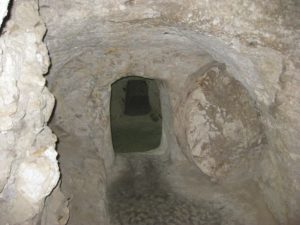 We go to the Sisters of Nazareth Convent and meet with Sister —-, who takes us down to the remains of a Byzantium church discovered beneath the church while digging out a cistern. But—and this is the part most intriguing to me—beneath that, discovered only recently, are the remains of a first Century home. This is the only home dating to the time of Jesus found so far in this area. Supposedly, when the land was sold to the church, it was done at a very high price by a woman who justified it by saying it contained the tome of the Righteous One. And sure enough, right under the house is a tomb with some four chambers in it. We ask the sister who the Righteous One is. “How can we know?” she smiles. “The only one we know of being called that in the New Testament is Joseph [the father of Jesus].”
We go to the Sisters of Nazareth Convent and meet with Sister —-, who takes us down to the remains of a Byzantium church discovered beneath the church while digging out a cistern. But—and this is the part most intriguing to me—beneath that, discovered only recently, are the remains of a first Century home. This is the only home dating to the time of Jesus found so far in this area. Supposedly, when the land was sold to the church, it was done at a very high price by a woman who justified it by saying it contained the tome of the Righteous One. And sure enough, right under the house is a tomb with some four chambers in it. We ask the sister who the Righteous One is. “How can we know?” she smiles. “The only one we know of being called that in the New Testament is Joseph [the father of Jesus].”
Who can know. But the thought is extremely alluring.
We take coffee in a small shop. A (I am guessing) bishop of the Greek Orthodox church comes in in his hat and robs, long, billowing sleeves. Outside on the step, a large billboard proclaims the sovereignty of Islam. The green and crescent-adorned dome of a mosque peers up behind it.
Back at the hotel, Shabbat is coming to an end. Life is lazily resuming on a day when people check out from hotels later than normal in the afternoon. So few patrons remain tonight that dinner has been moved to the smaller bar area. We drink wine from the Golan Heights. Upstairs I catch the end of American Idol.
February 7: Elijah
Cold. I am tired of being cold. I have been living in my long underwear, my polar fleece headband, polar fleece neck thing, and the down coat for which I thought I would be seriously mocked. (Tourists and pilgrims from other groups compliment me on it in passing, most enviously, one of them quoting scripture to the effect that one who has a better coat should give it to the one with the lesser, to which I pleaded ignorance. And a lack of English. Which doesn’t work as well when it’s a member of your own group).
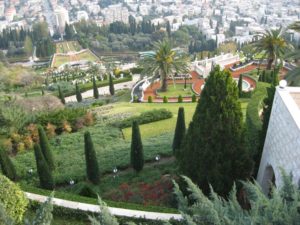 The Bahai garden is here leading down to what is presumably a domed temple, but it is covered today. I’ve had friends who are Bahai–what I didn’t realize is what a young religion it is–less than 200 years. I think it was founded around 1830, actually. Knowing little about it except about its universalist themes, I can attest that the gardens are indeed immaculate.
The Bahai garden is here leading down to what is presumably a domed temple, but it is covered today. I’ve had friends who are Bahai–what I didn’t realize is what a young religion it is–less than 200 years. I think it was founded around 1830, actually. Knowing little about it except about its universalist themes, I can attest that the gardens are indeed immaculate.
We visit the Stella Maris church built over the “Cave of Elijah.” This church was built by Crusaders who had formerly been living hermit and Elijah-style in caves. Though the domed painting of Elijah in his chariot is gorgeous, the dome style itself reminiscent (at least to my eye) of larger ones in Rome, it is of less interest to me on this trip. A service begins as we are standing in the narrow narthex. We head back into the cold. I am irritable and bored and freezing as Amnon decides to talk at some more length, telling the story of Elijah, fed in the desert by ravens. As he says this, a raven chooses this moment to caw loudly from a nearby palm. And, just as I am grousing about standing here in the cold, two ravens swoop in and drop a pinecone a few yards away. I am the only one who notices and blink at it for several moments.
The funny thing is, pine cones are edible.
We go to the Hecht Museum in Haifa to meet with marine archaeologist Kurt Raveh and to view a boat pulled out of the Mediterranean. We wander the museum and grab some yogurt from the student union; one never knows when (or if!) Amnon will stop for lunch. And then Kurt is coming with us to take us to the maritime museum at Dor, and then to the top of the sea-cliffs at Dor to walk through a settlement there, up in the wind designed to carry away the smells of a stinky tannery, to fan the flames of a bakery.
Let me say something about Kurt. He came here to fly planes for the army and eventually to dig and teach. Between flying around, going to the Dept. of Antiquities and having artifacts stolen to show up later (even in the States), he is a real-life (marine) Indiana Jones. He’s got some artifacts in his backpack, wrapped up in a paper bag (that’s how much there is here—artifacts everywhere, potshards everywhere, history in pieces, everywhere); they’ve already appeared in some articles. One is a statue that looks a lot like Astarte, but it’s Tanit—similar in use and worship to Molech—a far less benign deity, one to which some parents sacrificed their children. Amnon and Kurt argue about whether Tanit is really Molech or not.
I should say something now, and this is pure speculation, but it is this, and it has been the occasional topic of a larger conversation in this group: that when Abraham started to sacrifice Isaac and then was stopped by God, this is the illustration of the fact that he was being called to be set apart, different from his pagan, (sometimes child-sacrificing) contemporaries. Speculation, but these stories in context tend to have a lot more meaning, and considering that he was surrounded by worshippers of Molech or Baal… well, you can decide for yourself.
I learn that the Mediterranean doesn’t have much for tides. There is no regular tidal movement here. The explanation is a bit beyond me, but it has something to do with the channel and the phases of the moon, but not the usual kind of morning and evening movement of the ocean.
Back at the hotel, I actually hit the gym. It hits back.
February 8: Hades
I forgot to add from yesterday that for every five ships that left port in ancient times, only two might make their destination. That’s why there’s so much crapola (some of it shiny) in general dumped all over the ocean floor—including sites only 70 meters from shore, which is where Raveh found the ship we saw in the museum along with a bunch of other things. Raveh’s dog even found a large cache of something or other (the joke goes that this dog is the most famous maritime archaeologist in Iareal) just off the beach during a family picnic. When Raveh opened the paper to read see how the story broke, there was no picture of him—only the dog.
Near the Scottish hospital in Tiberius, Jewish guys wait for the bus in their hoodies, tzitzits dangling against their jeans. We go to Bernice Hill, named after the “scandalous” Queen Bernice, daughter of Agrippa I, great grand-daughter of Herod the Great. She was (I believe) once poised to become Empress of Rome. It’s a story I’d like to visit at some point—though perhaps not in its own historical context, but a fantastic one. Remind me of this when I’m done with my next book and bemoaning the fact that I don’t know what to write next.
We are headed up to the long corner between Lebanon and Syria near the foot of Mt. Hermon. The last few nights I’ve had wine from Golan Heights, which is just east of the highway we’re on now.
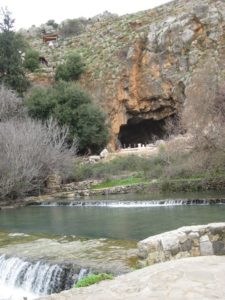 Hazor is the first stop Abraham made coming down into this area from the north. Here are Israelite ruins on top of Canaanite ones. In the “high place” (holy place) of the tel inside the 30-foot walls is a large protrusion from the floor. It is, how shall I say, phallic in shape and nature. In other words, it looks like a waist-high penis. Again, no wonder: for ancient peoples, half the children of which die by the age of 6, for who old age is 35, for whom malaria might be the death sentence of an entire community and rain is a blessing because without it you cannot grow your crops and eat, for whom children are the ultimate blessing and hope of propagating your people—your main shot at continuity, if not immortality… fertility is everything. There are some archaeologists who don’t recognize this particular stone as serving this symbolic purpose, though it ultimately doesn’t matter; it does not change the facts or priorities of the time.
Hazor is the first stop Abraham made coming down into this area from the north. Here are Israelite ruins on top of Canaanite ones. In the “high place” (holy place) of the tel inside the 30-foot walls is a large protrusion from the floor. It is, how shall I say, phallic in shape and nature. In other words, it looks like a waist-high penis. Again, no wonder: for ancient peoples, half the children of which die by the age of 6, for who old age is 35, for whom malaria might be the death sentence of an entire community and rain is a blessing because without it you cannot grow your crops and eat, for whom children are the ultimate blessing and hope of propagating your people—your main shot at continuity, if not immortality… fertility is everything. There are some archaeologists who don’t recognize this particular stone as serving this symbolic purpose, though it ultimately doesn’t matter; it does not change the facts or priorities of the time.
Consider that a man like Abraham, facing the prospect of children beyond count, would be facing a giant promise. I think I blogged a day or so ago that there is a good possibility, I believe, that Abraham was once affected by the pagan philosophies of his neighbors and that God’s command to him not to sacrifice Isaac was his call to be set apart from the norm of the day. The more Astarte figures I find in Jewish history, the more I see the range of piety in early Israel (as in any religion) and the more I understand, too, scriptures where God bemoans Israel’s worship of other gods.
Speaking of perspectives, a few of us muse that it is a shame we cannot have the dual perspective of a Palestinian guide, but they are not able to be licensed here.
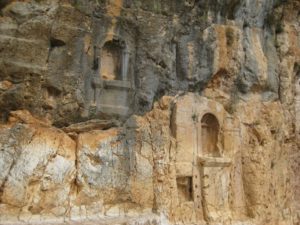 The Jordan river starts at the foot of Mt. Hermon. This is the area of Caesarea Philippi. Up the hill, the water comes out of the rock in several places, though in the time of Christ it would have come out of the mouth of the great cave, considered by pagans of the time to be the gate to Hades. There is water in the cave, which served as an offering place to Pan. Offerings taken down to the underwater tunnels without incident were considered to be accepted. If blood appeared anywhere after the fact, it was not accepted (and then, I suppose, someone would get upset at someone for having botched the job.) Along the face of the mountain to the right of the cave are carved alcoves that once housed images for votive offerings. And farther to the right are the ruins of a Temple to Zeus.
The Jordan river starts at the foot of Mt. Hermon. This is the area of Caesarea Philippi. Up the hill, the water comes out of the rock in several places, though in the time of Christ it would have come out of the mouth of the great cave, considered by pagans of the time to be the gate to Hades. There is water in the cave, which served as an offering place to Pan. Offerings taken down to the underwater tunnels without incident were considered to be accepted. If blood appeared anywhere after the fact, it was not accepted (and then, I suppose, someone would get upset at someone for having botched the job.) Along the face of the mountain to the right of the cave are carved alcoves that once housed images for votive offerings. And farther to the right are the ruins of a Temple to Zeus.
In the sharp ear between Lebanon and Syria we take lunch and Amnon talks about the six-day war of ’67. These are details I know little about; my interest in history has never included much of what I consider the present. Amnon talks about Israel being down to its last bullet and Nixon opening the American artillery in Europe. “For that, I will take my hat off to Nixon until the day I die,” he says, doffing his cap.
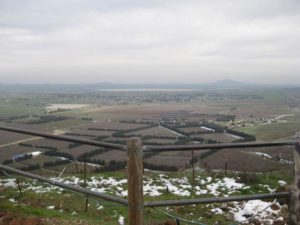 There’s a lot of talk about this strip of land, which I have just laid eyes on, that may pass again into Syrian hands. On a nearby hill stands a cluster of satellite dishes and antennae, the “eyeballs” of Israel. They provide Israel about 20 seconds warning of anything incoming.
There’s a lot of talk about this strip of land, which I have just laid eyes on, that may pass again into Syrian hands. On a nearby hill stands a cluster of satellite dishes and antennae, the “eyeballs” of Israel. They provide Israel about 20 seconds warning of anything incoming.
Back on the bus, more talk about Syria, the 6-day war, Lebanon. Meanwhile, my mind is on my manuscript, on Judas, the clash of present-day reality and seemingly endless history here, before the Israelites, or even the Canaanites or Egyptians, or Neolithic farmers, the Stonehenge-like traces of which remain in sites such as Gamal (see below), where the sun shines on the center of a megalithic maze on—what else?—the longest day of the year.
During all this time, I am thinking of stories. It always happens like that; one looks more shiny and intriguing always than the current one, and I hear murmurs of it like those of the bee in the broom tree, buzzing as I try to concentrate on what’s in front of me. And so I’ve been stroking the short hairs of a new idea—fantasy—inspired by some of these early lives. I have a strong sense that Iscariot may be my last straight Biblical fiction, at least for a while.
Can I just point out that we are going all over the place here, and it is truly a small area, this country. Small wonder the Old Testament is filled full of wars and raids for the best fertile valleys, water.
“If you have a gun, you can write history,” Ron points out. It’s true.
The Qatzrin Museum, housing artifacts and presentations about the findings and digs at Gamal, is of great interest to me because of the time period; this is a village situated exactly as described by the historian Josephus (made available after the 6 days’ war), which fell at the beginning of the Great Revolt. The city has more or less been preserved as it fell. In a few days we go to Masada to see the famous mountain-top city that fell at the end of the Revolt.
As we leave Gamal, gunfire crackles in the distance. I have heard it numerous times since arriving, including from my hotel room. We pass a UN military policeman in his car as we return early to Tiberius. I haven’t checked my e-mail for two days and have not worked on my manuscript for as many. So tonight is a work night.
And then I’m getting a massage.
February 9: Shards
I am staring at the boat found in the sea of Galilee—the Jesus boat to pilgrims, “Frankenstein” to archaeologists because it is thrown together of so many kinds of wood. Of far more interest to me is the demonstration of the tallit, the Jewish prayer shawl with the knots on its edges, given to me by a worker in the gift shop. She hows me how it symbolizes the covering of the law, how one draws together the corners of it, winding the long strands of the tzitzits through the fingers and bringing them to the forehead in order to pray for the return of Israel’s children. Forget the boat, preserved ten years in solution so it can stand on its metal frame in the museum—here is a living thing.
We go from there to the Mount of Beatitudes, which has a church on it today. I have by now seen the remains or the sites of so many Biblical events that it is starting to—I don’t want to say that it is getting lost on me, but I am by now missing a little of the mysticism that has been stripped bare of simple stones in the dirt. I don’t have great faith in mysticism or in superstition, and I have even less use for tradition. But there are moments when the Sea of Galilee is smooth as glass and it might be Lake Tahoe if you look at it askance… when the mount here might be a hill anywhere else covered in verdant green. I feel a little sacrilegious saying that, but if anything, it drives home the idea that the cornerstone of my faith is less about this place or these objects, and more about what was done here and with them. Though I admit to gaining a great deal more context.
We visit the House of Anchors Museum at En Gev, a maritime museum—so here I can see now the kind of nets Peter would have used, weighed down by small stones bored through with holes. This is the day we eat the obligatory St. Peter’s fish lunch. And it tastes a lot like… a fried fish.
I am by now starting to be bored by the same flavor profile everywhere. Shawarma, falafel. Salad. Olives. Chicken broth. I am actually dying for some bacon. I would love a ham and cheese sandwich. I hate to admit this—I am a seasoned world traveler and complaining seems ungrateful and pedestrian. But if I’m honest, I would be mean to a small child right now if it meant eating pork chops for dinner.
We go also to Korazim, condemned by Jesus for its unbelief. We see the synagogue, which faces Jerusalem, and sit on cold stone tiers along the wall. I am surprised but no longer scandalized to see an image of Medusa on one of the lintels.
We spend the rest of the day in Hippos tracking through the ruins with one of the archaeologists of this site from Haifa University. There I see preserved the actual footprint of a Roman soldier—there are the nails in the bottom of his shoe. There I note ancient graffiti on a column of the cardo, the mason’s mark on the stone of the street itself. The past whispers in fragments as scattered as the ever-present pottery shards upon the ground.
The white broom tree is in bloom—the smell is strong and sweet, reminding me of plumeria. Beyond the ruins snake coiled wire fences and bright yellow land mine warning signs.
That evening I head out for dinner, eat pasta and chicken-liver pate at an Italian restaurant just up the street from our hotel in Tiberius. I ought to work. I ought to write. But I am tired.
February 10: Mikva
I’ve been waiting to visit Sepphoris for days because it figures prominently in the early chapters of Iscariot. This is the Galilean capitol, the city Jesus might have worked in. It is here in 4BC that a rebel took the city in one of several revolts during the end of Herod’s life.
But enough about Sepphoris—if you want to know more, you’ll have to buy the book (Please tell me I’m not taking notes like a crazy monkey for nothing. 😉
I can, by now, spot the opening of a cistern from fifteen yards—a mikva/ritual bath from thirty. Sepphoris has many of both.
Capernaum is famous because of Jesus’ preaching in the synagogue. And though there’s a spectacular hanging church there and tons of the devoted, we only stay a little while.
There’s a money changer in the parking lot of Capernaum—I recognize him as the same man who rode a short way with us yesterday as we returned to Tiberius, exchanging currency for some of the group on the way.
I find in my earlier notes that the Philistines jealously guarded the secret of bronze and bronze-smithing. Cain’s descendants were supposed to be metal-smiths. I wonder if there’s some connection there. There’s a random thought for you.
Beit Shean is the site where Saul and Jonathan’s bodies were hung on the city walls. It was the most westerly city of the Decapolis and its residents were killed during the Great Revolt.
We eat lunch before tackling the ruins: turkey hot dog. In a pita. With hummus.
A random goat comes along and eats the leftovers, the paper wrappers, the garbage. My shoe.
Incidentally, my Hebrew name, given to me by my adopted Jewish mom and dad, is Yael. It means “goat.” Though I’d like to point out that goats are climbers–ostensibly ascending to the High Places and, you know, doing otherwise really important things.
Or they’re just looking for pork products in a kosher country.
I know. I am so going to Sheol.
The ruins are huge. A series of mosaic-clad rooms bearing the image of Tyche crown the cardo. “What do you think this was?” Amnon asks.
Government? Priestly quarters? Merchant booths?
“Prostitution,” I speculate. Because, frankly, everything we’ve seen goes back to something like that.
And so it is, turns out.
Ron, Elliott (both from Manhattan), Mike (from Colorado) and I climb the tel where there are older ruins from the time of David and Solomon, destroyed by Shishak of Egypt. The Egyptian governor’s house is up top dating to 12 BCE.
We drive south through Palestine as the scenery goes from lush to sand. Greenhouses swath the banks of the Jordan. Jordan the country rises from the foothills of its banks. Past Palestine, the Dead Sea is grey and flat. Clusters of date palms, planted in neat and unnatural rows stop and start, a strange oasis against an inhospitable background.
Dinner is the same-old, same-old—buffets for the hotel guests seem to be the rule here; I have yet to see any sit-down-order dining. Just salad, fruit, cheese, fish and bread buffet for breakfast, soup, fish, salad again for dinner. With pickles. And hummus. And did I say hummus?
February 11: Float
Masada is amazing. Herod the Great was a monster, but he was responsible for some serious building. We pack in the cable car like live sardines and spill out at top. We sit in the synagogue, wander the Herodian palace, consider the cistern system—rainwater runs down the canyons into several collection holes.
It’s warm today; I’m wearing cut-offs. On this trip we have seen rain, sleet, snow, hail and now this beating sun all in the space of ten days.
And then we hike down. Forever. I will not be needing to work out tonight. Or next week.
We visit the waterfall at Ein Geddin. A waterfall in the desert is a major event, and this is where David hid out from Saul (that David and Saul sure got around). I don’t go see the waterfall. I eat French fries at the Ein Geddin store, check out the stinky mud products instead. Everything here smells like sulfur.
Back at the hotel, I run down to the beach. The sun seems to set early here in this valley 400 feet below sea level. It is just barely warm enough to wear shorts, let alone a swimsuit, so I squeal and take off running into the salty water for the obligatory float in the salt. I’m at the Dead Sea; it’s a moral imperative.
Floating. See? Floating, floating—okay. I get out, run for clothes, hotel, shower, massage.
Afterwards, I wolfed down some more hummus on some yogurt cheese chickpea falafel pita shawarma.
No I didn’t. I squealed all the way down the street to McDonald’s for some truly international cuisine.
Note: There are no cheeseburgers here (dairy and meat together isn’t kosher).
PS: What is it about those double Royales? I have never seen a burger that huge at McD’s—or pretty much anywhere.
February 12: Stumble
I no longer fall asleep like a vampire at sunset. Though I would, by now, steal bacon from a baby. Or ham from a little old lady.
Who knew that pork deprivation was the ultimate test of one’s true nature? I’m embarassed that, having been weighed, I have come up so woefully short.
Qumran is desolate. I have seriously begun to wonder why someone would live out here, but I guess if you’re an Essene and live a life so strict as to not even move your bowels on the Sabbath (seriously), then desert conditions and a serious lack of amenities may not be such an issue.
I climb part way up to Cave (12? 1? 4? Work with me here) before looking down the narrow and rocky (and un-railed) path along the rocky ravine before deciding a broken leg would put a serious crimp in my personal style.
We stop by the crossroads en route to the Jordan—on the way to John the Baptist’s site. But the Jordan today is a trickle and there’s nothing in that way now but a muddy creek about eight feet wide (that would be the Jordan), and lots of Bedouin trash on the way. Kind of a downer for a holy site, if you know what I mean.
I doze against our bus’ window pane for only a short while before we arrive at Mt. Scopus. This is a small country. I forget that, but how much light it sheds on all the conflict that has happened on this soil.
Out on my feet, I rub bleary eyes and go down the steps (steps, steps, always steps here!) to the lookout. And there I am, looking out over Jerusalem, the Dome of the Rock in the distance.
I stare at it for what seems a long time. To my left is the Mount of Olives. Street vendors are trying to sell us bookmarks, maps, postcards, bookbags. Meanwhile, I tell myself I am looking out over Jerusalem. Here it is, the Holy City. It is crowded, buildings and houses and churches piled upon a hill, spilling over it onto the ones nearby.
“Bookmarks? Posters. Two dollars,” one guy says. Hey. I’m trying to have a religious experience here. But I feel strangely distant and outside myself.
“No. No thank you,” I tell him. I own a zillion bookmarks. I don’t want any stuff. I have progressively picked up a traveling library to add to my already-extensive archive at home.
Another vendor comes by. “Even though you don’t buy, we still love you,” he says. His skin is old and lined and leathery. I blink at him and smile some.
Amnon takes us somewhere inside the city, near the city’s original spring. This is supposed to be the location of the Best Hummus on Earth. Which, by now, I am about as eager to eat as… a bowl of hummus. I eat some Hummus With Meat. I have already had Hummus With Beans, Hummus With Cucumber… and veggies and olive oil and a basket full of pitas. Turns out, spieced ground beef in hummus is really nice—mostly because it changes the flavor of the dish almost completely.
After that the group goes on to the church over the spring, but I return to the bus. It feels really good to play hooky. Anyone who knows me knows how well I do with routine, schedule, and structured days in general. That I’ve been on point since the 1st means Jesus is definitely coming.
I’m war-driving on the bus—that is to say, I’m latching on to a random internet connections to get my mail, blog, check Facebook.
The hotel is the least nice of all that we’ve stayed in. They’ve mostly been older, outdated, overly room-freshened and not kept clean enough despite being dubbed First Class hotels. I’ve been in worse—in Romania. And yet I hear they’re better than the ones in Jordan.
I’m anxious to see the Old City and take off with Ron and Mike.
We miss the Jaffa (Western) gate, double back and find it partially under construction. Inside the Jewish quarter Menorahs, Mezuzahs, pomegranate candle holders are for sale. A lot of it is tourist junk—the same from store to store. We pass through into the Christian quarter past more Menorahs, shawls, shoes and creepy Jesus pictures the eyes of which follow you no matter which way you move. The shop owners are aggressive. “Please, come inside. Just look, you don’t have to buy! Can I ask you a question? What are you looking for? Please. This is a new store. You are my first customer of the day/last customer of the night/it’s been a slow day/I want to make you a special deal.”
Mike finds his favorite antiquities dealer, a Christian preacher named Zac who runs next door for Cokes for us. Mike is perusing two thousand year-old olive oil containers, honey pitchers. Me, I’m in the market for old coins.
Mike openly laughs at me as I systematically reject Byzantine and Roman and Greek coins, looking for Second Temple Period, settling on a Herod the Great. I have become such a Biblical history snob.
I briefly turn over a Tyrian silver shekel—the same coin with which Judas might have been paid. I say “briefly” because it costs $900.
After that, Mike asks about a bathroom. “The closest one is probably at the Church,” Zac says. We head down the street.
“The church” turns out to be that of the Holy Sepulcher.
It’s late, most of the pilgrims have cleared out. I blink against the darkness and walk right on in. Before me lies the slab where Christ’s body was said to be prepared for burial, illuminated by a wealth of hanging lanterns.
I’m in a weird state of—I don’t know what. I did not expect to happen upon this church, not tonight. I am having a hard time reconciling what it is supposed to be with my being here, so absolutely unprepared.
We talk about it, walking back to the hotel. Ron is a scientist and pastor, Mike is a former pastor and professor. I am grateful for their company, their insights, their opinions.
Shabbat has come in while we’ve been adventuring. Back at the hotel, we get taken hostage by the Shabbat elevator. It goes all the way to the top and begins its slow descent, stopping on every floor.
“Agh! Let’s get a different one!” I say on 10. Mike jumps out, but then the doors—which run on a timer on Shabbat—close. Ron and I jump out on 9, hit the Down button. Another elevator arrives, the doors open. There is Mike.
The dining room is full. Families run rampant, young couples on dates (he in his tzitzits, she in dark hose) talk out on the sofas. I eat dinner: fish, hummus, salad. I am so disinterested in food.
February 13: Feel
I am still feeling the stairs from Masada. And Korazim. And Hippos. And all over the Old City.
It is Shabbat. Breakfast is cold. Dinner will be, too. There’s a basin for washing before eating at the front of the restaurant. This hotel seems to run a more observant service than the others we’ve stayed at.
The pilgrims and tourist groups we did not see at the archaeological sites we see now as we descend from Gethsemane, past old graveyards—terraces of graveyards, gardens of stone—toward the Kidron Valley.
A Man is begging on the street outside of Gethsemane, an olive branch clasped in the same hand that holds his plastic cup. “God bless you, God bless you,” he says.
There are the tombs of patriarchs here, pyramidal and ancient, cut through in some places where thieves in ages past hoped to find goods. But Jews don’t bury their dead with possessions. A shepherd herds goats just down the way. Father on, the valley curves into Hinnom, where ancients sacrificed children in the fires to Molech, giant drums drowning out the sound of cries. Gahenna comes from the name of that place—where fires burn, the hell of the Bible.
“Hello! Hellloooo!” Up the hill, coming down from the city is a band of travelers, waving at us. It takes me a minute, but then I recognize them as the Slovenians we gave a ride to coming out of the Mount of Beatitudes. We greet them, take a picture. “We have a saying in Slovenia—the third time we meet, we go drinking together.”
Makes sense to me.
We peer through a window in a sidewalk fence at the dig in progress in the City of David. We’ll be there tomorrow. Just then a shepherd rides by on a horse, trailing a string of four goats on leashes.
We go into the city to St. Anne Church—Anne, named after the mother of Mary. There are ruins here, outside the church. Ruins, ruins, everywhere. My adopted Jewish mom joked once that you can stick a spade in the dirt and uncover something here. It’s true.
I am by now really tired. Tired, and having a tough time reconciling the ancient city of David with the patriarch’s monuments with the Hinnom Valley with the Old City… with this church with that of the Holy Sepulcher with its hole where the cross was to have gone into the ground (you can get under the altar and poke your head into it if you want) and its undecorated tombs just off the tomb that is supposed to be that of Christ, and the slab where his body was to have been prepared. I watched a woman lay her baby there, touching the slab and his forehead and back and again—a baptism of sorts, a baptism of death, practically-speaking. I’m having trouble reconciling it with the rugs and fresh-squeezed pomegranate juice for sale along the Via Dolorosa with its stations marked by giant spiked signs, the Arabs asking if we’d like to go into their stores.
I was most moved standing at the ruins outside St. Anne’s, “Jesus always has ways to help you,” it reads, beneath a quote from John 5. I look at the hand-lettering and wonder who wrote those words and so carefully penned them.
Outside the Lion Gate is an Arab cemetery. A little boy comes over, his face looking haggard, his hand out, but his clothes are new. His brother is nearby, waiting for him to bring him the goods. I give the kid a few shekels anyway.
Today has been hard, emotional and disjointed for me.
We are supposed to take dinner at the home of a Biblical Archaeology Review editor who lives here. I opt out, drink some wine with Mike and Ruth and David downstairs before the rest of the group leaves.
Dinner for me happens half a block away at a restaurant called Paridiso. I ask the waiter for recommendations. “What kind of food are you interested in?”
“Anything without chickpeas in it,” I say.
I eat the best pot roast of my life as the stars appear and Shabbat goes out.
February 14: Hidden
I am worn and worn and worn out. I would have a hard time choosing between bacon and a massage right now.
It’s warm and sunny—did I actually see snow just a week ago? I have seen snow, hail, rain, and sun in the space of these two weeks, gone from my down coat and long underwear to cut-off sweatpants and t-shirts.
I failed to include yesterday our return to the Western Wall (Amnon does not like to call it the Wailing Wall—he is very emphatic about that). It was Shabbat, and bar mitzvahs were taking place everywhere. The drums were enticing, the blow of the shofar always amazing to me. Life events seem to happen at the Wall—wedding portraits, family portraits around aging patriarchs in their wheelchairs, the carrying of the torah scrolls for bar mitzvahs on days like today.
We meet up with Hillel Geva, one of the archaeologists overseeing the City of David, where digs are in progress. It’s lunch time; we’ve come across the volunteers taking lunch in the shade at long tables.
We visit Hezekiah’s tunnel (I take the Canaanite one—Hezekiah’s has water in it, though you can go wading if you want to). They’re narrow—one person wide, assuming the person isn’t too wide—toward the end. It comes out in the Siloam Pool.
I am seriously sore in the legs. Sitting down on anything—a step, a curb, a bench—feels so very good. But I dare not say a word about the fact that every time I sit down I want to groan; I am the youngest one here. There is a 79 year-old on this trip trucking along most of these places with help of her walking stick.
We tour spacious mansion ruins near the site of the Temple—archaeologists are always shy to speculate, but it would not be outside the realm of probability that the High Priest might have lived here, that Jesus, on midnight trial, might have stood in this courtyard or graced these underground chambers for a short time as the others tried to decide what to do about him.
My strange disconnect continues; I have not felt at all what I thought I would here. I am at odds with myself.
Ron and Mike and I have been talking about the miracles of Jesus. As a scientist, Ron has a dimension to his discussions about origins, God, miracles, that resonates with a familiarity of questions for me. Ultimately, I leave the discussion with this kernel: less important than changing the natural law (in regenerating cells), was what Jesus accomplished in people. I speculate that the heart of a person is far harder to change than a person’s chemistry.
Tonight I take dinner with Rick and Mike, around the corner from the hotel at an Italian restaurant. Tomorrow I plan to skip the afternoon museums and wander those streets one last time.
February 15: Found
Two weeks have gone by just like that, and I am struggling still with the strange disconnect I’ve felt since arriving in Jerusalem.
This morning is traditionally market day, and bar mitzvahs are in wild progress all along the Western Wall, in the ruins, among the southern steps. The beat of the drummers is infectious, the shofar sends chills up my arms (I gotta get me one of those). They make their way to the Western Wall, carrying the Torah scrolls, female family members standing on chairs to peer over the fence that divides them and watch.
There are soldiers everywhere. Ron has talked to some of them–many of them from the states, dual citizens. Either I am getting older or they seem inordinately young.
We pick our way along the Southern Steps that would have led up to the Herod’s Temple. It was truly gigantic.
I want to go back into the Old City, plan to skip the museums this afternoon. But could not resist visiting the Temple Mount this morning with the group.
And who do we find there? The Slovaks, once again. This is the third time–and we take pictures and ask them what they like to drink. A few of our group exchange e-mail addresses with them, but I am wanting to get on with looking here, and be done with touring.
But by the time we pause in front of the mosque, make our way up the steps, I am growing progressively more emotional, so glad for the huge sunglasses covering most my face. And I realize that I have not felt what I thought I would, here. I have seen pilgrims and tourists and souvenir-sellers. Throngs of people clamoring with nametags, tallits and prayer rugs, for God. From here the skyline is an array of church steeples and domes like hands reaching for heaven. But they are just that: hands and rugs and shawls and steeples. I feel very empty.
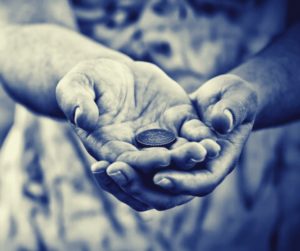 Up the steps toward the golden dome, there is a Muslim woman begging against a pillar. I give her all the change I have, barely a dollar. She clasps my hands in both of her dry ones.
Up the steps toward the golden dome, there is a Muslim woman begging against a pillar. I give her all the change I have, barely a dollar. She clasps my hands in both of her dry ones.
And I think: Here is God. At last.
I take the rest of the day in the Old City, stopping for a hamburger in a basement grotto of a hip little bar in the Christian quarter. I go one last time to the Church of the Sepulcher. I visit the Bathroom of the Sepulcher, too. I manage to buy absolutely nothing, which proves miracles are still in effect today.
That evening, we gather at dinner as a group before a few of us head out to Picasso’s to chow down in earnest. I’ve found fettuccine with bacon in it.
I am so grateful for this trip, but more than the sites and the stones, for the people. And though I have much to process from the lectures of the archaeologists, the discussions we’ve had in our small knots and pairs throughout the last two weeks, and am not sure how best to articulate it, I am certain now that our methods–by heritage, by stone, by geography–must falter when we lay claim to God, that in the end all that matters is that He has laid claim to us.






geometry dash
Posted at 03:15h, 24 NovemberWow, great post. It gave me a lot of useful information. I look forward to your next posts. Play geometry dash subzero online.
arunkrishna
Posted at 06:50h, 23 FebruaryNice Blog Tosca Online Training
Colleen B. McChesney
Posted at 17:49h, 07 AprilThanks for sharing your wonderful stories and insights of your travels through Israel and the Holy Land.